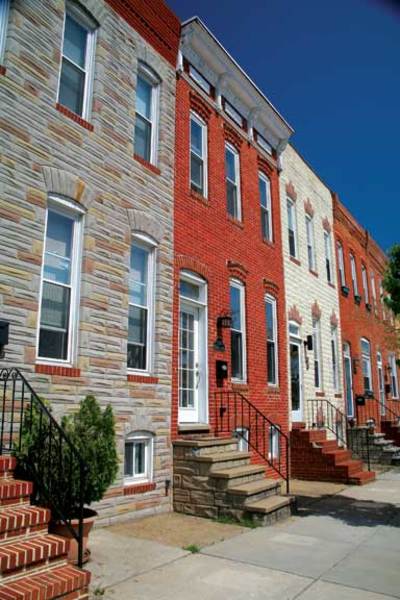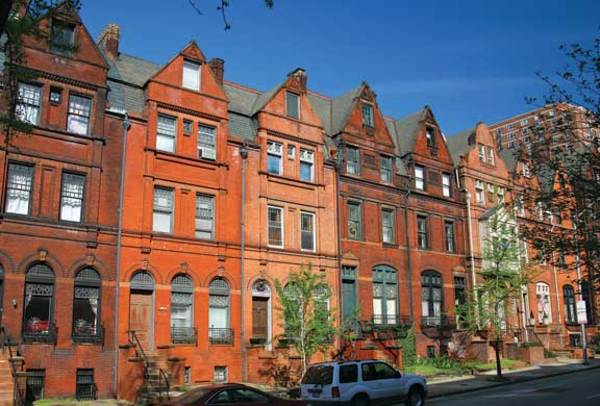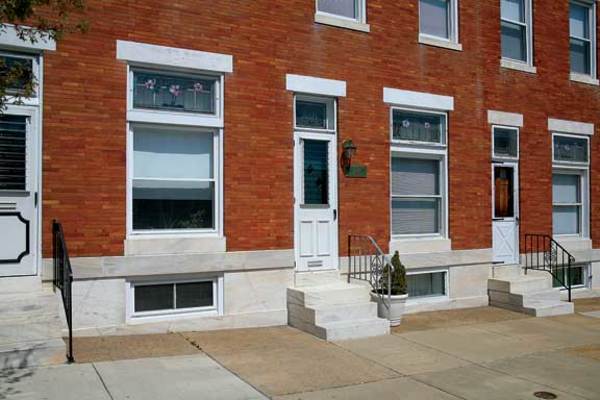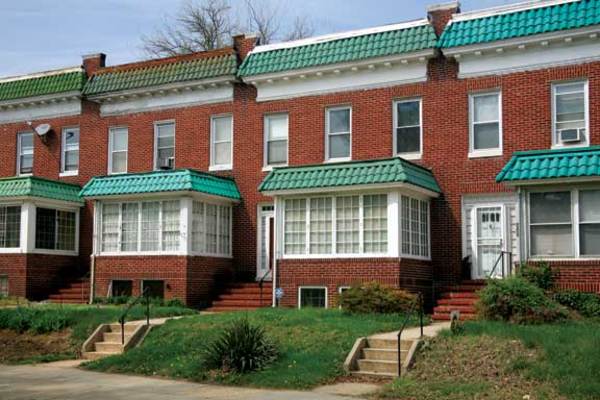
Two Baltimore traditions side by side: a workman’s brick row house amid Formstone-covered neighbors.
Row houses came to America with the first British settlers and formed the backbone of East Coast cities.
Practical, adaptable, and attractive, they’ve never passed wholly out of fashion. Boston, New York, Philadelphia, and Washington all have blocks upon blocks of row houses. But while other cities built row houses by the hundreds, Baltimore built them by the thousands.
Until the automobile and the suburbs beckoned, Baltimoreans of every ethnic and economic background lived in, and loved, their row-house neighborhoods. Many still do—and they have lots of company.
Baltimore Row Houses are a Range of Rows
The city’s collection of row house styles, sizes, and amenities is vast. A few are Federal or Greek Revival mansions facing formal squares or parks. Many more are narrow 19th-century workers’ homes, stretching from block-end to block-end near the waterfront, where they were convenient to factory jobs of an earlier era.

J.A. Wilson’s Belvedere Terrace (1879) is one of the nation’s most distinguished Queen Anne rows.
Others are proud middle-class residences sporting the architectural furbelows of the late 19th and early 20th centuries. Finally, far from the urban core are early 20th-century “daylights”—wider houses with full front porches that brought sun and air into the interior—with neat yards and often little garages. The majority of all types were originally owner-occupied.
In addition to owner occupancy, three other essentials turned Baltimore’s rows into neighborhoods: convenient alleys, corner stores and bars, and, above all, convivial marble stoops.
Defining a Row House

Canton rows display stained-glass window and door transoms, and the famous white marble stoops regularly scrubbed by generations of Baltimore housewives.
A row house is a home that shares a party wall—a single wall between buildings—with its immediate neighbor on each side. Baltimore row houses are set within a sizable, unbroken grouping of residences built at or near the same time. The basic row house is two stories, two bays, and 12′ to 14′ wide—though it can be both taller and wider. Shared alleys serve the rear of the buildings.
The closer to a major avenue or boulevard the house was located, the larger and more elaborate it was likely to be. The smallest and simplest row houses, no more than 12′ wide, were on secondary streets and even alleyways. Two stories high and two bays across, they had just four rooms: two downstairs and two above.
Upscale Amenities

Enclosed front porches mark these 1920s-era “sunlight day-parlor” houses in Waverly.
The homes of more prosperous working families were larger, airier, and better lit; two or three stories high; mostly 12′ to 14′ wide, but occasionally 16′; and three bays across. They had a first-floor parlor with a side hall, backed by a dining room, with two bedrooms above. A narrow rear wing provided space for the kitchen on the first floor and more bedrooms on the second. Every room had at least one window—except the bathroom, which usually made do with a skylight. In row houses of all sizes, front doors are dauntingly narrow, but wide parlor windows often presage the picture windows of the 1950s.
The end units in a block often housed stores or bars, with the entrance in a clipped corner to serve both front and side streets.
Baltimore row-plans varied little until the advent of the 20th-century “daylight” or “airlight” house. In addition to the front porch, airlights eliminated the rear wing, allowing two rooms across per floor. Glassed-in front porches, or sunrooms, appeared around 1915, producing an almost suburban air of spaciousness.
Adaptability has been the key to survival for Baltimore’s oldest house type. Despite cycles of intense industrialization, explosive population growth, suburban flight, urban blight, removal, and revival, the row house continues to rule the streets of this modern city.







